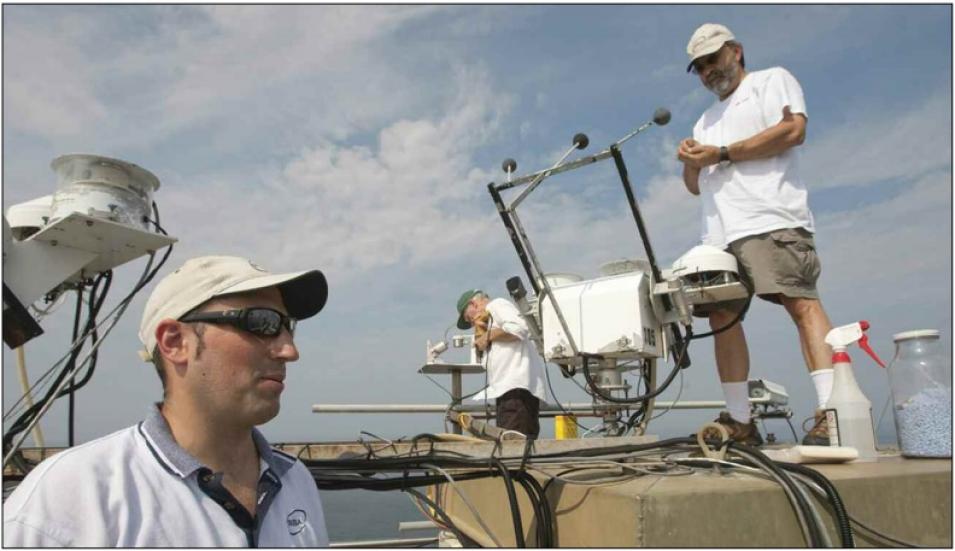Schuster said, “We’ve got satellites that measure the energy budget at the top of the atmosphere, and then ways to infer the energy budget at the surface, so we can capture the radiative properties of entire columns of the atmosphere as the satellites pass over the Earth. The COVE data indicate that we’re doing a better job of computing what is at the surface than at other locations.”
A long time series
While only a single validation site, COVE plays an important role in the accuracy of these global satellite measurements. Fabbri said, “There’s no other validation site like this in the world; to our knowledge, it’s the only true water site. When modeling flux from the top of the atmosphere to the surface, COVE data model the best.”
So the COVE team maintains its regular flights to the lighthouse site. Fabbri said, “We fix instruments when something breaks, or if we have a new instrument, we test it in the lab first and then deploy it to the lighthouse. We have to maintain power and communication systems. We have solar power, a generator, large batteries, and two wind generators.” The lighthouse itself is fully automated and unmanned, so they have to be self sufficient too. Denn added, “We’re off of the grid. It’s a self-contained structure. We take our own food and water. If we had to stay for three weeks, we have enough.” Happily, they have never been stranded that long. Usually, the helicopter fetches the team back to land and home at the end of the day—except on the occasions they plan to stay overnight, or are marooned by bad weather.
Denn said, “It’s great fun working out there, as long as there’s a lot to do.” And there is still a lot to do to understand clouds and energy, so they hope to continue the trips for years to come. Fabbri said, “We need more measurements that quantify clouds and Earth’s energy budget better. That’s why multiple satellites have gone up: the longer time series you have, the more information we have on the effects of clouds.”
References
Kratz, D., S. Gupta, A. Wilber, and V. Sothcott. 2010. Validation of the CERES Edition 2B surface-only flux algorithms. Journal of Applied Meteorology and Climatology 49: 164-180. doi:10.1175/2009JAMC2246.1.
Levy, R., L. Remer, J. Martins, Y. Kaufman, A. Plana-Fattori, J. Redemann, and B. Wenny. 2005. Evaluation of the MODIS aerosol retrievals over ocean and land during CLAMS. Journal of the Atmospheric Sciences 62: 974-992. doi:10.1175/JAS33391.1.
Rutledge, C.K., G.L. Schuster, T.P. Charlock, F.M. Denn, W.L. SMith Jr., B.E. Fabbri, J.J. Madigan Jr., and R.J. Knapp. 2006. Offshore radiation observations for climate research at the CERES ocean validation experiment. Bulletin of the American Meteorological Society 87(9): 1,211-1,222.
Zibordi, G., et al. 2009. AERONET-OC: A network for the validation of ocean color primary products.
For more information
NASA Atmospheric Science Data Center (ASDC)
CERES Ocean Validation Experiment (COVE)
Clouds and the Earth's Radiant Energy System (CERES)
| About the remote sensing data |
| Satellites |
Terra and Aqua |
| Sensor |
Clouds and the Earth's Radiant Energy System (CERES) Instrument |
| Data sets |
Clouds and Computed Flux Profile Data Sets |
| Resolution |
Globally averaged, gridded regional, zonally averaged |
| Parameters |
Clouds and computed flux profile |
| DAAC |
NASA Atmospheric Science Data Center (ASDC) |


